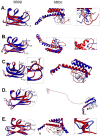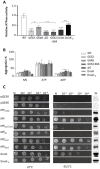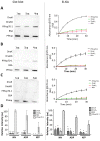Mutation of GGMP Repeat Segments of Plasmodium falciparum Hsp70-1 Compromises Chaperone Function and Hop Co-Chaperone Binding
- PMID: 33672387
- PMCID: PMC7926355
- DOI: 10.3390/ijms22042226
Mutation of GGMP Repeat Segments of Plasmodium falciparum Hsp70-1 Compromises Chaperone Function and Hop Co-Chaperone Binding
Abstract
Parasitic organisms especially those of the Apicomplexan phylum, harbour a cytosol localised canonical Hsp70 chaperone. One of the defining features of this protein is the presence of GGMP repeat residues sandwiched between α-helical lid and C-terminal EEVD motif. The role of the GGMP repeats of Hsp70s remains unknown. In the current study, we introduced GGMP mutations in the cytosol localised Hsp70-1 of Plasmodium falciparum (PfHsp70-1) and a chimeric protein (KPf), constituted by the ATPase domain of E. coli DnaK fused to the C-terminal substrate binding domain of PfHsp70-1. A complementation assay conducted using E. coli dnaK756 cells demonstrated that the GGMP motif was essential for chaperone function of the chimeric protein, KPf. Interestingly, insertion of GGMP motif of PfHsp70-1 into DnaK led to a lethal phenotype in E. coli dnaK756 cells exposed to elevated growth temperature. Using biochemical and biophysical assays, we established that the GGMP motif accounts for the elevated basal ATPase activity of PfHsp70-1. Furthermore, we demonstrated that this motif is important for interaction of the chaperone with peptide substrate and a co-chaperone, PfHop. Our findings suggest that the GGMP may account for both the specialised chaperone function and reportedly high catalytic efficiency of PfHsp70-1.
Keywords: GGMP repeats; Hop; Hsp70; Plasmodium falciparum; chaperone; malaria.
Conflict of interest statement
The authors declare no conflict of interest. The funders had no role in the design of the study; in the collection, analyses, or interpretation of data; in the writing of the manuscript, or in the decision to publish the results.
Figures








Similar articles
-
Characterisation of a unique linker segment of the Plasmodium falciparum cytosol localised Hsp110 chaperone.Int J Biol Macromol. 2021 Jun 1;180:272-285. doi: 10.1016/j.ijbiomac.2021.03.056. Epub 2021 Mar 16. Int J Biol Macromol. 2021. PMID: 33741370
-
Comparative Characterization of Plasmodium falciparum Hsp70-1 Relative to E. coli DnaK Reveals the Functional Specificity of the Parasite Chaperone.Biomolecules. 2020 Jun 4;10(6):856. doi: 10.3390/biom10060856. Biomolecules. 2020. PMID: 32512819 Free PMC article.
-
Insertion of GGMP repeat residues of Plasmodium falciparum Hsp70-1 in the lid of DnaK adversely impacts client recognition.Int J Biol Macromol. 2024 Jan;255:128070. doi: 10.1016/j.ijbiomac.2023.128070. Epub 2023 Nov 18. Int J Biol Macromol. 2024. PMID: 37981279
-
The structural and functional diversity of Hsp70 proteins from Plasmodium falciparum.Protein Sci. 2007 Sep;16(9):1803-18. doi: 10.1110/ps.072918107. Protein Sci. 2007. PMID: 17766381 Free PMC article. Review.
-
Molecular chaperones HscA/Ssq1 and HscB/Jac1 and their roles in iron-sulfur protein maturation.Crit Rev Biochem Mol Biol. 2007 Mar-Apr;42(2):95-111. doi: 10.1080/10409230701322298. Crit Rev Biochem Mol Biol. 2007. PMID: 17453917 Review.
Cited by
-
Introductory Chapter: The Importance of Heat Shock Proteins in Survival and Pathogenesis of the Malaria Parasite Plasmodium falciparum.Adv Exp Med Biol. 2021;1340:1-9. doi: 10.1007/978-3-030-78397-6_1. Adv Exp Med Biol. 2021. PMID: 34569019
-
Heat Shock Proteins of Malaria: Highlights and Future Prospects.Adv Exp Med Biol. 2021;1340:237-246. doi: 10.1007/978-3-030-78397-6_10. Adv Exp Med Biol. 2021. PMID: 34569028
-
Biophysical Reviews 'Meet the editor series'-Addmore Shonhai.Biophys Rev. 2021 Mar 11;13(2):167-169. doi: 10.1007/s12551-021-00794-w. eCollection 2021 Apr. Biophys Rev. 2021. PMID: 33927784 Free PMC article.
-
Supporting data on characterisation of linker switch mutants of Plasmodium falciparum heat shock protein 110 and canonical Hsp70.Data Brief. 2021 May 29;37:107177. doi: 10.1016/j.dib.2021.107177. eCollection 2021 Aug. Data Brief. 2021. PMID: 34141839 Free PMC article.
-
Characterization and Inhibition of the Chaperone Function of Plasmodium falciparum Glucose-Regulated Protein 94 kDa (Pf Grp94).Proteins. 2025 May;93(5):957-971. doi: 10.1002/prot.26779. Epub 2024 Dec 13. Proteins. 2025. PMID: 39670568 Free PMC article.
References
-
- Zininga T., Ramatsui L., Makhado P.B., Makumire S., Achilinou I., Hoppe H., Dirr H.W., Shonhai A. (-)-Epigallocatechin-3-gallate inhibits the chaperone activity of Plasmodium falciparum Hsp70 chaperones and abrogates their association with functional partners. Molecules. 2017;22:2139. doi: 10.3390/molecules22122139. - DOI - PMC - PubMed
MeSH terms
Substances
Grants and funding
LinkOut - more resources
Full Text Sources
Other Literature Sources

